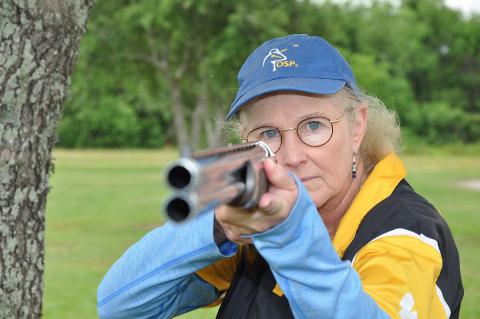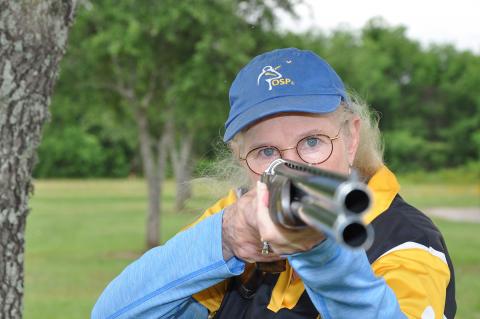
We have shooters fill out our shooter form on our Knowledge Vault website on a weekly basis and ask many questions from mental performance to gun mount to follow-through to choke and so on.
While each gets a personal answer from one of us three, several evolve into a relationship that goes beyond just another question that we answer and turn into a video tip in our Quick Tips section or talk about in our podcasts.
A recent questionnaire from an experienced shooter mentioned that he was going over to the dark side and begin shooting sporting clays because trap was boring and skeet was not much better. He wanted to know the best way to proceed in building a sporting clays game.
Gil asked him when he shot trap, what was his method of getting the gun in front of the target, to which he responded: swing through. He added that he did the same in skeet and had reached the proverbial wall in both and could not get better. Gil asked one simple question: “Do you look down the barrel as you mount the gun to make sure the gun is mounted correctly and then look back for the target?” “Yes, sir,” was the answer and we all knew what his problem was.
In trap you know the point of origin but you do not know the line of the target, so you can shoot trap effectively swinging through the target. But most of the shots in trap are going away from you at very narrow angles.
In skeet, swing through is not quite as effective as maintained lead, due to the many crossing trajectories. The game is very repetitive and all targets are known distances, directions and speed. When shooting doubles in skeet, if you can break the first shot 15 feet before the stake with minimum movement, then when you flick your eyes to pick up the second target, you will see it coming to you and it will appear to slow down as you move with it and match speed. The reason minimum movement is critical is because every bit of movement and speed of the movement on the first target in doubles must be overcome to switch directions and efficiently and effectively hit the second target of the double.
There is one more huge similarity in the targets in skeet and the targets in trap. That is that the targets in skeet are the same speed and the targets in trap are all the same speed also. Targets in sporting are not only rarely the same speed or angle or distance or even the same size, making for some optical allusions that will never be found in trap or skeet.
We are not saying they are simple games or easy to master, but you must admit they are the same whether played in frozen butt Alaska or San Antonio, Texas. High two is high two and wide right on Station 5 is the wide right on Station 5 regardless where the targets are thrown or shot! When played at their highest levels, you will find that less gun movement is a common thread in all great performances, and not looking down the barrel of the gun in the setup is another not so frequently mentioned, but essential fundamental in all clay target sports.
When you break down all the clay target games to their base level, everything in the games is designed to make you speed up or hurry when practicing and when performing them. Tournament jitters in any of the clay games makes your heart rhythm increase and your breathing get short and labored and your hands shake with anticipation. Most detrimentally, your eyes bounce from one thing to another, making it impossible to see the target clearly shot-to-shot-to-shot.
While experience in playing the games and more deliberate practice will lessen the felt pressure (which is self-induced), it will still be there and it will tend to make you rush and speed-up your mount, the amount of time you take between shots or pairs as well as the amount of time you take between stations. During this chosen situation that you paid to put yourself into, what you do just a little in practice will be done a lot when playing the games for score, especially the better you are shooting.
Skating when playing hockey gives you mobility on the ice. In fact, it gives you more speed and agility than you have when walking and running. You had better not have to think about what you are doing with your feet when ice skating or, what’s worse, look at your feet.
This is the comment we hear often when we see shooters who shoot gun up and when they mount they are looking down the barrel to check the alignment of the bead sights. When we ask why they have to keep looking at the barrel to see if the gun is mounted correctly and mention they should learn to mount the gun so they don’t have to constantly check the gun in the setup, the say: “I don’t need to learn to mount the gun because I shoot gun up!” News flash, the amount of muzzle awareness in the shot will always be equal to or greater than the amount of muzzle awareness in the setup!
Let’s face it, when shooting a shotgun at a moving target, you must be focused on the target and the gun must be ahead of the target to hit it, right? So, when you pull the trigger you can’t focus on both the gun and the bird because they must be in two different places, right?
Having to look down the barrel to make sure the gun is mounted correctly is something that we see that is detrimental to high level performances and, in fact, assures that the barrel will be more noticeable in your shots! Our good friend and renowned skeet coach Terry Hetrick of Double Guns of Nashville says: “Never put anything in your pre-shot routine that you don’t want in your shot!” We could not agree more, especially when it comes to the muzzle of your gun.

Dean Troute from California had a realization when he had a breakthrough in his sporting practice a year or so ago. He shared it with us on one of our past pod casts. After having an incredible practice at all levels one afternoon, Dean called me and said he had a breakthrough. “You are either in the cage with the gun or down range with the target and you can’t be in two places at one time!” he said. He had finally practiced his gun mounts and done the OSP Flashlight drill and the OSP Three Bullet Drill every night for long enough when we made the comment about muzzle awareness in the setup causing a problem. He just stopped and “Bam,” a new level of awareness in his game. He still does the drills and his gun mount is the strongest part of his game. It creates a consistency that will not be experienced otherwise.
Doesn’t it just make sense to learn to move and mount the gun in the beginning of learning the game and eliminate the crutch of check the barrel and then looking back at the trap for the target? The visual anomalies that checking the barrel before you call pull causes is a list that is unending. The out-of-body experiences it creates have been puzzling shooters for decades and we guess it will never end.
Our friend from the trap field did email back after doing the gun mount drills and shared with us that the drills were not as easy to do as he suspected. He did not realize just how much he was looking at the end of the barrel in the setup!
If you are one of those who is trying not to look at the barrel in the shot but continually checks the barrel for alignment in your setup before calling pull, try not looking at the barrel and see what happens. You, as well as our friend who is coming over to the dark side, will be surprised at just how much you are really looking at the barrel in your setup.
Dribbling in basketball and skating in hockey without looking at the ball or your skates give you mobility on the court and on the Ice. Everything you do with the gun must become like holding your breath when you swallow in order for you to really concentrate on the target.
Mastering what you do with the gun is the most basic fundamental in shotgun shooting and what you do with the gun must be done without thinking. It is the one thing that either accelerates or holds back how fast you learn and improve. It either allows for you to begin to understand and implement the subtleties of the game or hides them from you forever. You only have 100 percent of focus. Every bit you put on the gun comes off the target. You are either in the cage with the gun or down range with the target. You can’t be in two places at the same time.–Gil and Vicki Ash
